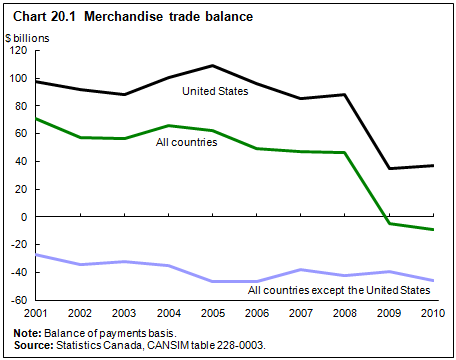International trade
Archived Content
Information identified as archived is provided for reference, research or recordkeeping purposes. It is not subject to the Government of Canada Web Standards and has not been altered or updated since it was archived. Please "contact us" to request a format other than those available.
Related information
Canada's international merchandise trade rebounded in 2010 from substantial declines the year before; however, exports and imports remained below levels seen just prior to the 2008–2009 recession. Reliance on the United States as a trading partner eroded further in 2010 as trade with Asia, particularly China, expanded.
On a balance of payments basis, exports grew 9.5% from $369.5 billion in 2009 to $404.6 billion in 2010 and imports rose 10.6% from $374.1 billion to $413.6 billion. As a result, Canada's trade deficit nearly doubled from $4.6 billion in 2009 to $9.0 billion. This was the second straight year Canada had an annual trade deficit.
Industrial goods and materials lead growth in exports
Exports grew in 4 of 7 sectors in 2010. The growth largely resulted from volumes rising 8.3% while prices increased by 1.1%. Even with these gains, the value of exports remained below those posted from 2004 to 2008. Machinery and equipment exports declined for a third consecutive year in 2010, and the sector lost its place as Canada's top exporter.
In 2010, the top export was industrial goods and materials, which rose 21.8% during the year to $96.5 billion. Prices and volumes both increased. Precious metals exports led the way and reached a record high, a reflection of growing demand and rising prices for gold and silver on the global market.
Automotive products exports climbed 29.7% to $56.8 billion, but remained $41.1 billion below their peak in 2000. The 2010 gain resulted from volumes increasing 40.4% while prices fell. This marked automotive products' sixth price decrease in the past eight years, while the increase in volumes followed four consecutive years of declines.
Volumes up in all import sectors
All import sectors recorded growth in 2010, with automotive products and industrial goods and materials accounting for nearly two-thirds of the growth. Import volumes increased 15.7% while prices fell. During the year, the Canadian dollar rose 4.6% against the U.S. dollar and appreciated 15.3% against the Euro.
Automotive products imports grew 24.2% from 2009 to $68.7 billion in 2010 as voumes rose. Truck imports reached their highest level since 2007, reflecting Canadians' demand for full-size pickup trucks no longer made in Canada. Parts imports grew after five consecutive years of declines.
Industrial goods and materials imports rose 15.7% to $86.9 billion on higher volumes. Imports of metals and metal ores—especially precious metals—reached unprecedented levels, and were the main factor. While prices of metals and metal ores increased during the year, the growth was largely due to higher volumes of trade in this subsector.
Machinery and equipment imports grew on the strength of new electronic products that entered the market in 2010. Engines, turbines and motors also contributed, thanks to wind farm expansion projects in Canada. The value of energy products imports also rose in 2010, largely because of higher prices.
Trends in trading partners
On a balance of payments basis, Canada's trade surplus with the United States increased from $34.9 billion in 2009 to $36.6 billion in 2010, mostly because trade in auto products regained some strength following large declines in 2009. The trade deficit with countries other than the United States, however, widened from $39.5 billion in 2009 to $45.7 billion in 2010.
On a customs basis, North America continued to be the most important export destination for Canada's trade in 2010, accounting for 76.1% of all exports. This share has contracted from 87.1% in 2001, shrinking in 8 of the last 10 years. During that decade, the share of exports going to Europe and Asia nearly doubled.
As with exports, the proportion of Canada's imports coming from within North America has contracted, from 65.7% in 2001 to 56.8% in 2010. The share of imports from Asia has shown the largest growth—20.2% of imports in 2010, up from 13.6% in 2001.
Although the United States is still Canada's largest trading partner, its share of Canada's total merchandise trade (exports and imports combined) shrank to 62.6% in 2010, down from 76.3% in 2001. Over the same period, Canada's total trade with China more than tripled from 2.3% to 7.2%. The top exports to China in 2010 were wood pulp and similar pulp, coal and other bituminous substances. The top import from China for the past decade was computers.
- Date modified:

